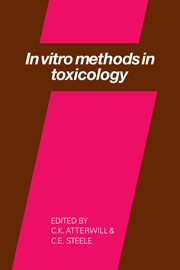Book contents
- Frontmatter
- Contents
- List of contributors
- Preface
- Introduction
- TARGET ORGAN TOXICITY
- GENERAL AND TOPICAL TOXICITY
- REPRODUCTIVE TOXICITY
- An in vitro test for teratogens using cultures of rat embryo cells
- Postimplantation embryo culture and its application to problems in teratology
- Sub-mammalian and sub-vertebrate models in teratogenicity screening
- The use of in vitro techniques to investigate the action of testicular toxicants
- An in vitro assessment of ovarian function: a potential tool for investigating mechanisms of toxicity in the ovary
- CONCLUSION
- Index
The use of in vitro techniques to investigate the action of testicular toxicants
Published online by Cambridge University Press: 06 August 2010
- Frontmatter
- Contents
- List of contributors
- Preface
- Introduction
- TARGET ORGAN TOXICITY
- GENERAL AND TOPICAL TOXICITY
- REPRODUCTIVE TOXICITY
- An in vitro test for teratogens using cultures of rat embryo cells
- Postimplantation embryo culture and its application to problems in teratology
- Sub-mammalian and sub-vertebrate models in teratogenicity screening
- The use of in vitro techniques to investigate the action of testicular toxicants
- An in vitro assessment of ovarian function: a potential tool for investigating mechanisms of toxicity in the ovary
- CONCLUSION
- Index
Summary
INTRODUCTION
The testis performs two main functions that are largely complimentary, namely the production of spermatozoa and the production of hormones, principally testosterone. Any perturbations of either of these activities will result 1n reduced fertility. Generally, damage to testicular function can result from either Inhibition of the overall hormonal controlling mechanisms at the hypothalamic - pituitary or testicular level, or by direct action at the testicular cell level. Chemicals and drugs can exert their toxic effects via one or both of these mechanisms.
A number of morphological and functional parameters are employed to assess toxic effects on male reproduction, however the conventional methods used are mainly Involved with the overall controlling mechanisms, for example blood hormonal measurements, sperm analysis and fertility profiles. Histopathology and biochemistry provide an Insight Into events at the testicular level, but there 1s a need for a further reliable and fast method which will provide more detailed Information of events within the testis.
The testes consist of the seminiferous tubules, containing Sertoli cells and germ cells Involved 1n spermatogenesis (which make up over 90% of the testicular mass) and Interstitial Leydig cells (Figure 1). The endocrine control of spermatogenesis 1s very complex (Setchell, 1978; di Zarega and Shervis, 1981) Involving hormones from the pituitary (systemic) and Intragonadal hormones operating at a local level (paracrine) (Figure 2).
Information
- Type
- Chapter
- Information
- In Vitro Methods in Toxicology , pp. 411 - 424Publisher: Cambridge University PressPrint publication year: 1987
Accessibility standard: Unknown
Why this information is here
This section outlines the accessibility features of this content - including support for screen readers, full keyboard navigation and high-contrast display options. This may not be relevant for you.Accessibility Information
- 1
- Cited by
